- Lot
- Information
China Guardian (Hong Kong) announced that its 2013 Autumn Auction will be held at the beginning of October. Presenting seven sessions and a line-up of over 600 lots, the sale offers a remarkable selection of Chinese paintings, contemporary Chinese paintings, Chinese oil paintings, ceramics, furniture and masterpieces. Highlights include an evening auction titled Grand View: A Night in Hong Kong and a dedicated sale of 20th Century and Contemporary Chinese Art. Previews will take place on October 3rd and 4th and the auctions will be held on October 5th and 6th at Island Shangri-La.
“We were established in 1993 as the first auction house to primarily focus on Chinese antiques and artworks. This year marks the 20th anniversary of China Guardian and our third auction in Hong Kong. To commemorate this important occasion, we spent over six months examining collections around the world to find exceptional works for the Autumn Auction. Thanks to the support of different collectors, we are proud to present a significant number of masterpieces as well as our first evening auction and Chinese oil painting sale. Our goal is always to show renowned masterpieces, provide outstanding buying opportunities and at the same time, offer discerning collectors a multi-channel platform,” said China Guardian (Hong Kong) President Ms. Hu Yanyan.
Of particular note is China Guardian’s first evening auction in the city, titled Grand View: A Night in Hong Kong, which is taking place on October 5th. The theme of the inaugural auction is imperial court art, for which 17 masterpieces from the Chinese painting, oil painting, ceramic, works of art and furniture have been selected. This sale offers collectors the opportunity to own outstanding, museum-class masterpieces.
As part of the auction of Chinese paintings, China Guardian is honoured to present a selection of ten museum-grade pieces to collectors including Empress Yang’s Calligraphy in Regular Script album leaf from a renowned North American collector, Emperor Song Lizong’s Calligraphy in Regular Script album leaf, “Mi Dian Zhu Lin”(秘殿珠林) recorded by the Qing imperial court painter Zhang Weibang in Characters of Chinese Mythology, “Shi Qu Bao Ji”(石渠寶笈) recorded by Qing bibliographer and calligrapher Zhang Zhao in Calligraphy in Running Script.

Characters of Chinese Mythology by Zhang Weibang
In the Chinese ceramics category, highlights include three Qing Dynasty jade wares which were used by the Emperor and the royal family. An Imperial 'Zi Qiang Bu Xi' Jasper Seal (Qing Dynasty, Qianlong Period) and An Imperial 'Jing Yi Gu Xiang' Jade Seal (Qing Dynasty, Qianlong Period) originate from European collectors while A Finely Carved White Jade Mughal-style Jar (Qing Dynasty, Qianlong Period) is from the Walter and Phyllis Shorenstein collection. A Zitan Luohan Bed (Mid-Qing Period) in the furniture category is expected to draw intense bidding while the works of art category will present a Polychrome Lacquer Box and Cover Carved with Dragon Decoration (Qianlong Period). The auction also includes two Oriental Still Life oil paintings drawn by the Dutch artist Hubert Vos, whose artwork Portrait of the Empress Dowager Cixi has been collected in the Wenchang Gallery in the Summer Palace. This promises to be an extraordinary evening filled with a myriad of historical treasures.
For the first 20th century Chinese and contemporary art auction, China Guardian has carefully curated approximately 40 contemporary pieces of art and sculpture that will directly interest the Hong Kong market, some of which are appearing for the first time at auction. The works incorporate the theme of Western integration since the early 20th century and the sale features masters of contemporary Chinese art including Charm of Chinese Opera by Wu Da-yu, 18.10.98 by Zao Wou-Ki, Ombres Bleues and Composition No. 55 by Chu Teh-Chun and Untitled 08.12.19 by Zeng Fanzhi. Remarkably, this is the first time that Composition with Bamboo & Grass by Liu Ye has appeared at auction.
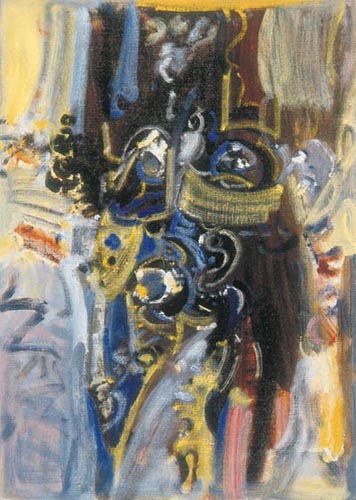
Charm of Chinese Opera by Wu Da-yu
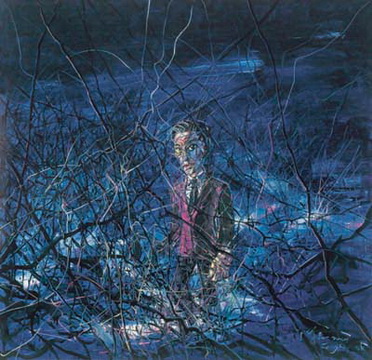
Untitled 08.12.19 by Zeng Fanzhi
The Chinese painting auction will present more than 330 exceptional art pieces. Of these, six rare paintings by Fu Baoshi have aroused a great deal of attention and interest among collectors as six of his works rarely appear in the same auction. The auction will also showcase masterpieces created by Zhang Daqian, Qi Baishi, Xu Beihong, Pu Ru, Li Keran, Lin Fengmian, Guan Liang and Wu Guanzhong as well as collections from Mr. and Mrs. Fei Zibin and Hou Biyi, Hu Hanmin, Hu Mulan, Mr. and Mrs. Lu Xiaguang and Ma Delan. Sourced from private collectors, many of these stunning artworks are appearing for the first time at auction. [!--empirenews.page--]
The Contemporary Ink Painting section focuses on paintings in Hong Kong and presents the best of artists including Lui Shou-kwan, Wang Ji Qian (C. C. Wang), Koo Mei and Kan Tai-Keung. A special auction featuring a private collection of Tai Jingnong’s calligraphy will demonstrate Tai’s varied and versatile style across couplets, scrolls and albums, inviting audiences to immerse themselves in his beautifully written world. In addition, Lute Playing and Zither Playing by Fu Baoshi, Cottages in Misty Mountains by Zhang Daqian, Landscape by Wu Guanzhong and Reading by Ren Yi will also draw buyers’ attention.
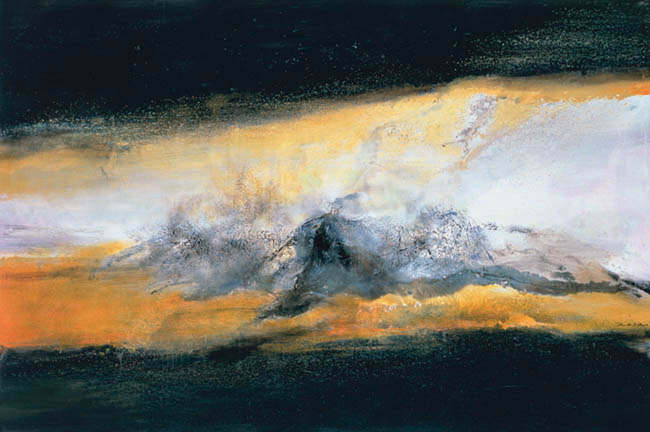
Cottages in Misty Mountains by Zhang Daqian
As part of the auction of Chinese ceramics, one of the most interesting lots is An Exceptionally Rare and Important Large Underglazed Red and Blue 'Mount Lu' Lantern Vase (Qing Dynasty, Qianlong Period) collected by the family of Florence Nightingale at Embley Park, Hampshire in England. Among purple clay wares, the highlight is the astonishing Robin's Egg-Glazed Purple Clay Teapot crafted by Mansheng Chen (Qing Dynasty, Daoguang Period).
The works of art and classic furniture of the Ming and Qing dynasty auction will feature Huanghuali Yoke-back Armchair (Early Qing Period), Huanghuali Seal Chest, Guanpixiang (Early Qing Period), Huanghuali Apothecary Cabinet with a pair of panelled doors (Early Qing Period), Huanghuali Flat-topped Side Table with Foot Stretchers and Dragon Designs (Early Qing Period).
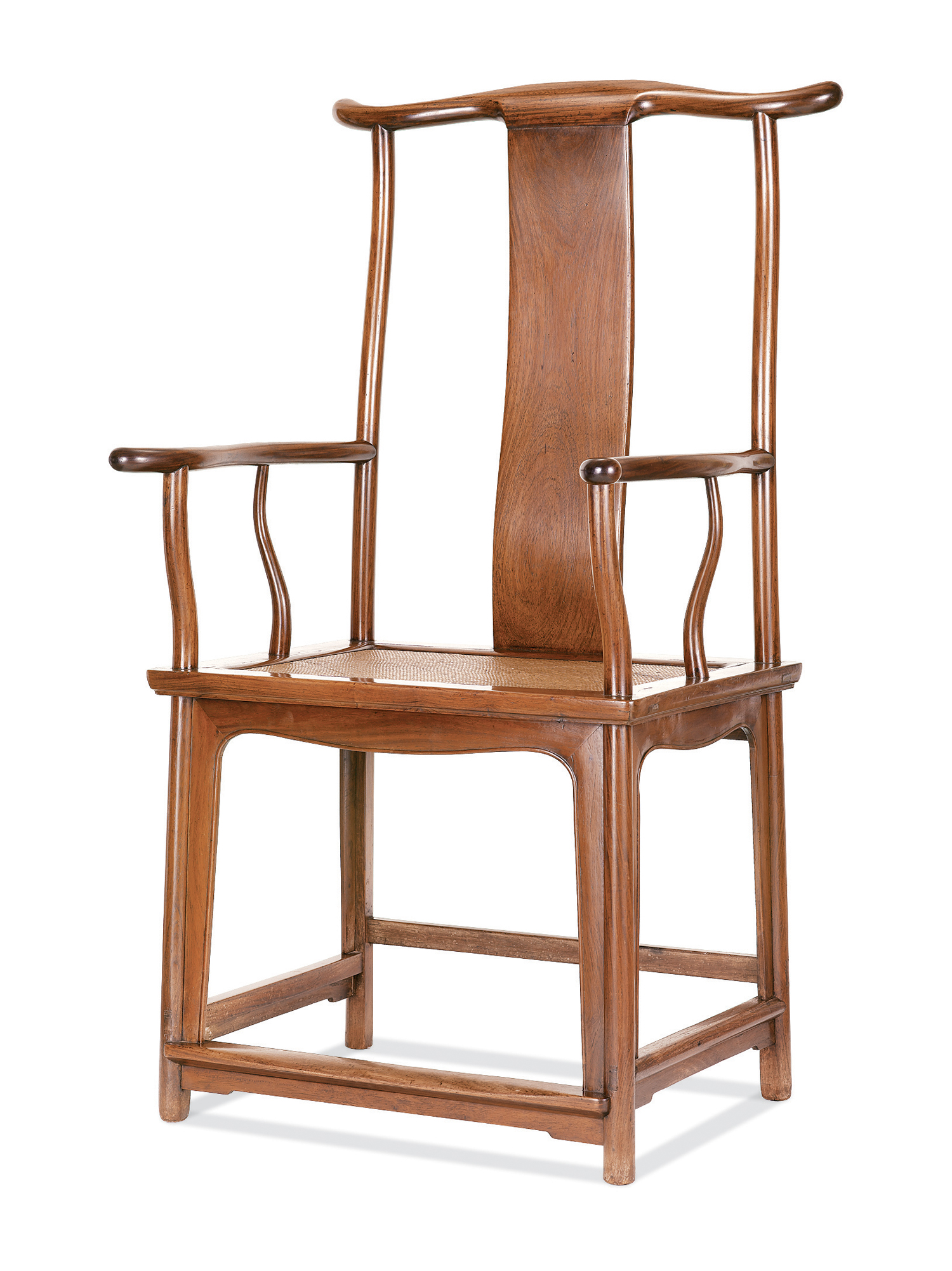
A Huanghuali Yoke-back armchair (Early Qing period)
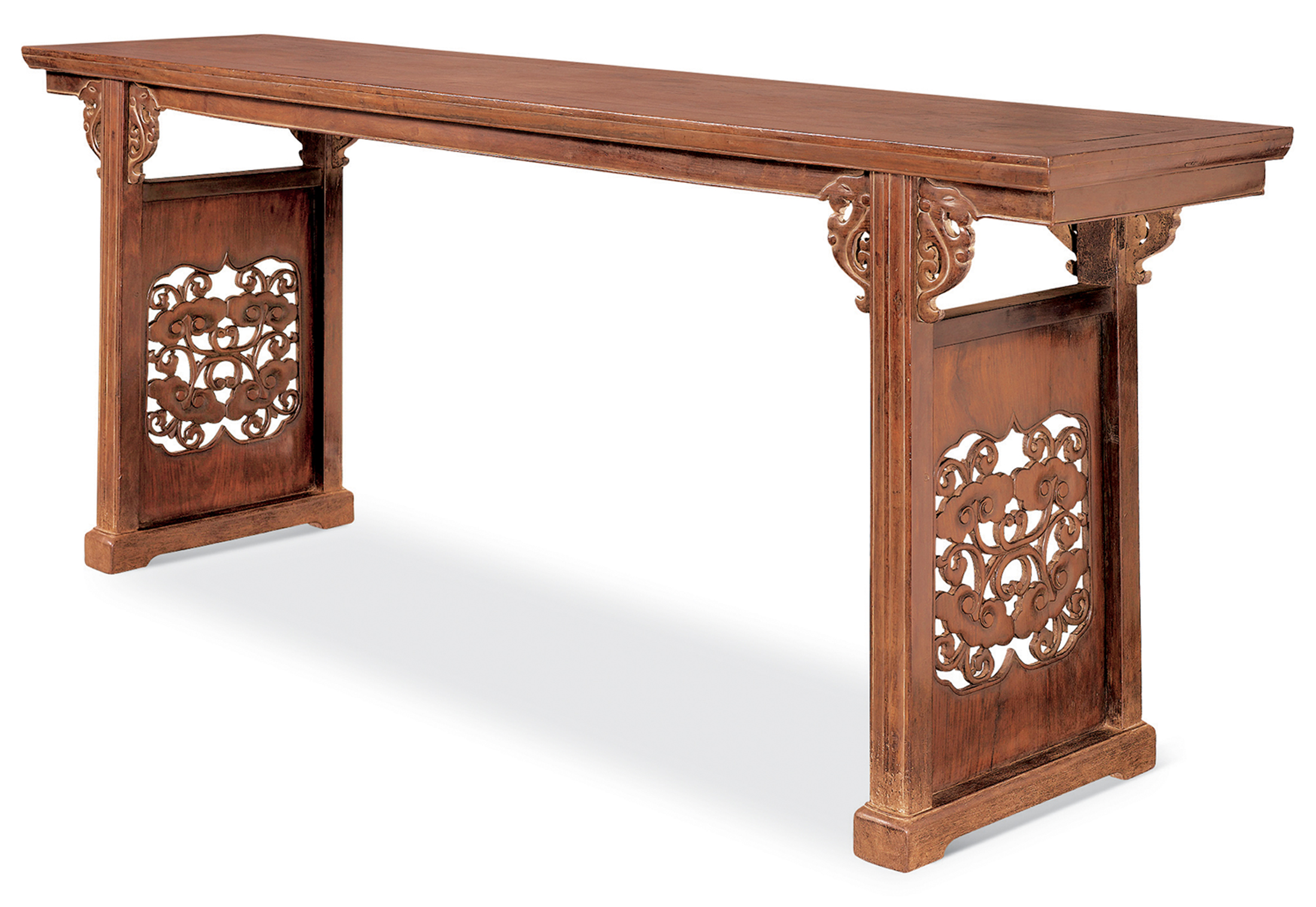
A Huanghuali Flat-topped Side Table with Foot Stretchers and Dragon Designs
A Precious Collection of Agalloch is yet another highlight of the Autumn Auction. This rare agalloch, originally from the Liang Yi Collection, originates from Vietnam and weighs 3.635 kilogrammes. This aesthetically pleasing and sinuous piece of agalloch, a term which describes the best quality agarwood, is one of the largest of its kind.
Part of the auction of Important Chinese Lacquer from a Private Collection is a set of elegant and delicate lacquers and vessels from the Song, Yuan, Ming and Qing Dynasties.[!--empirenews.page--]
Grand View: A Night in Hong Kong
Of particular note is China Guardian’s first evening auction in the city, titled Grand View: A Night in Hong Kong, which is taking place on October 5th. The theme of the inaugural auction is imperial court art, for which 18 masterpieces from the Chinese painting, oil painting, ceramic, works of art and furniture have been selected. This sale offers collectors the opportunity to own outstanding, museum-class masterpieces.
A selection of ten museum-quality masterpieces provides an exceptional opportunity for discerning collectors at the Chinese painting auction. Calligraphy in Regular Script, a fan by Empress Young of the Southern Song Dynasty and Calligraphy in Regular Script by Emperor Lizong of the Southern Song will be featured from the North American Bihushanzhuang Collection. In addition, Characters of Chinese Mythology by Zhang Weibang catalogued in “Mi Dian Zhu Lin” (秘殿珠林), Calligraphy in Running Script by Zhang Zhao recorded in “Shi Qu Bao Ji” (石渠寶笈), and the epic landscape paintings by distinguished artists including Qian Weicheng, Dong Banda and Yun Jeng from the Dingyuanzhai Collection of Zhang Xueliang will be notable highlights.
Among the court paintings produced during the Qing dynasty, Characters of Chinese Mythology is one of the standout paintings in this category. In the style of Lu Huang, Zhang uses energetic strokes, bright and refined colours, lifelike characters and the flowing lines to depict religious ceremony.
Lu Huang was an artist from the Southern Tang, one of the Ten Kingdoms in south-central China created following the Tang dynasty. Particularly skilled at drawing characters, towers and flowers, Zhang learnt Western drawing from Giuseppe Castiglione.
This artwork is one of the most valuable remaining pieces by Zhang and was catalogued in the third volume of “Mi Dian Zhu Lin” (秘殿珠林•三編).
Landscapes from Four Seasons by Qian Weicheng, collected by Chang Hsueh-liang’s studio Dingyuanzhai (定遠齋), captures the changing of the four seasons. These four landscape albums clearly show Qian’s excellent painting skills.
Although the composition of these paintings is deceptively simple, the different strokes add depth and complexity and the various blending techniques are evidence of Qian as a successor of literati landscape painting, in particular of the style of the Four Wangs.
In the same session, highlights include three Qing Dynasty imperial jade wares. An Imperial 'Zi Qiang Bu Xi' Jasper Seal (Qing Dynasty, Qianlong Period) and An Imperial 'Jing Yi Gu Xiang' Jade Seal (Qing Dynasty, Qianlong Period) originate from European collectors while A Finely Carved White Jade Mughal-style Jar (Qing Dynasty, Qianlong Period) is from the Walter and Phyllis Shorenstein collection.
This imperial “Zi Qiang Bu Xi” (自強不息) Jasper Seal claims a royal history. It is the corner seal in a set composed of the “Mao Qin Dian” (懋勤殿) and “Ba Zheng Mao Nian Zhi Bao” (八征耄念之寶) seals produced for the Emperor during the 54th to 59th years of the Qianlong period. The seal has been documented in the “Qianlong Bao Sou” (乾隆寶藪), housed in The Forbidden City in Beijing.
An Imperial “Jing Yi Gu Xiang” (靜挹古香) Jade Seal produced during the Qianlong period forms a set with the “Gu Xi Tian Zi” (古稀天子)and “Zhi Liang Yong Zhong” (執(zhí)兩用中)seals.
The seal was made 45 years into the reign of Emperor Qianlong and has been documented in the “Qianlong Bao Sou” (乾隆寶藪), housed in The Forbidden City in Beijing. The “jing yi gu xiang” (靜挹古香) seal mark, which appears on some of Emperor Qianlong’s personal paintings, is thought to have been made from this seal.
Another important piece, a Finely Carved White Jade Mughal-style Jar (Qing Dynasty, Qianlong Period) is from the Walter and Phyllis Shorenstein collection. It has been said that beautiful jade requires no cutting. To highlight the stone’s luminosity and shine, much of the jar remains untouched and has been crafted smoothly, leaving it as thin as paper.
In the Work of Art session, this Polychrome Lacquer Box and Cover Carved with Dragon Decoration (Qianlong Period) are painted in 3 colours: tawny brown, red and dark green. Intricately carved dragons inspire majesty and awe. Inside, the box is painted black and the base is inscribed with a six-character seal mark of the Qianlong period. Quality craftsmanship is evident from the detailed structure and refined polish.
Part of the classical furniture auction, the Zitan Luohan Bed (Mid-Qing Period) is made from zitan (red sandalwood) and displays the characteristics of furniture made during the flourishing Qing dynasty. The Baucourt pattern on the panels is composed of tripod ding-style burners, fang ding, yi, gu, lion-shaped gui handles, interlocking hands, ruyi, mountain carvings and scrolls. The thorough yet delicate craftsmanship lends the bed a feeling of timelessness and refined elegance.
This auction also includes two Oriental Still Life paintings drawn by the Dutch artist Hubert Vos, whose artwork Portrait of the Empress Dowager Cixi has been collected in the Wenchang Gallery in the Summer Palace.
20th Century Chinese and Contemporary Art Auction
China Guardian will host its first Chinese oil painting and sculpture auction in Hong Kong, titled 20th Century Chinese Oil Painting and Contemporary Art, during its 2013 Hong Kong Autumn Auction. Mr. Li Yanfeng, head of the China Guardian Contemporary Art Department, said, “Since the 1980s, Hong Kong galleries and institutions have played an important role in the Chinese contemporary art market. With excellent consignment resources and a mature collection system, Hong Kong has always been a key focus for China Guardian.”
For the Hong Kong Autumn auctions, China Guardian has selected approximately 40 pieces of art inspired by the cultural mélange of the East and the West and works by influential post-1989 artists. Lin Fengmian and Wu Da-yu are from the early 20th century movement that introduced Western techniques into Chinese art. Other notable artists of this movement included Zao Wou-ki, Chu Teh-Chun, and Wu Guanzhong while Liu Kuo-sung, Pang Jiun, Wang Huaiqing, Hong Ling, and Xu Lei have continued to create art in the same direction.
Works by artists from the post-1989 generation such as Xu Bing, Cai Guo-qiang, Yan Peiming, Zeng Fanzhi, Zhou Chunya, Liu Wei, Fang Lijun, Liu Ye, and Zhan Wang will also go under the hammer.
Charm of Chinese Opera, which was held by a prominent overseas collector for over 20 years, is the pinnacle of the series and has been featured in a number of authoritative publications of the artist’s work. Through powerful brush strokes which depict emotion and strength, Wu Da-yu’s pairing of Prussian blue, yellow and black with brown tones creates a grand colour scheme, representing the unique rhythm of traditional opera. The spirit, charm and momentum of Beijing Opera is visualised through dynamic brush strokes and a harmonious palette.
18.10.98, famous for its perfect composition, is representative of Zao’s work in the 1990s. At the time, Zao – who was over 80 years old – sought to represent his lifelong feelings towards nature using yellow, orange and black collisions and combinations. The Chinese Book of Changes declares that the sky is black and the ground is yellow. This painting, based on black and yellow hues, takes advantage of the ancient Chinese symbolism of these colours to imply a harmonious relationship between Heaven and Man. Using his preferred strong contrast between illusion and reality, as well as static and dynamic binding, Zao blends bright yellow hues with thin and transparent layers to create a dazzling visual effect. Making use of compatible painting materials, his natural transitions between yellow and dark green and use of complementary textures displays exuberant vitality and elegance. Zao’s deep knowledge of traditional Chinese techniques combined with his passion for contemporary Western art is clearly visible in this piece.
In addition, there are two eye-catching paintings by Chu Teh-Chun: one is an abstract painting using red, brown and black as the primary colours while the other uses energetic splashes of blue. Both artworks possess a great deal of appeal, particularly together, and function as a complementary set.
Composition No. 55 is a multi-layered piece crafted in 1960 and issued in a special Chu Teh-Chun art anthology in 2000. It previously belonged to a ground-breaking Asian private collection. Handsomely constructed using palette knife and brush, the canvas was texturized before a large swathe of colour was applied and blended using dark and light tones.
Ombres Bleues by Chu Teh-Chun, created in 1989, is a rare piece that measured 193 x 130cm. On the painting, the physical and the emotional combine to create a natural conversation between the tangible and the intangible, ephemeral and eternal, and Oriental lyricism and Western rationality.
In Untitled 08.12.19 by Zeng Fanzhi, a well-dressed man walks alone in a hazy forest. The foreground of the painting is scarred with a network of unnatural branches depicted in tense strokes. A light projects onto the man while the brightness of the man’s clothing in turn reflects onto the branches in the foreground, bringing brightness into an otherwise gloomy picture.
Much like other artists who identified with the literati movement, Zeng said his creations were focused on self-exploration; however, his works have gradually offered viewers clear insight into human personality and destiny.
In the past, Zeng was committed to exploring the experiences and psychological changes of his generation. His lesson to us all is that even in an era of rapid social and economic upheaval, we still need to calmly embrace change.
Liu Ye’s Composition with Bamboo & Grass was the first piece from his Bamboo series to appear at auction. It was first sold at the Hong Kong Art Fair in 2010 by the renowned Sperone Westwater Gallery in New York by an important Asian collector.
Composition with Bamboo & Grass is one of Liu Ye’s most significant explorations of structure, which he describes as more important than composition. He says it holds the key to unleashing powerful energy in art without the limitations of format, technique or vision. “Composition with Bamboo & Grass” is successfully detached from its structure through the use of clean colours and unpretentious lines. The simple form invites a sense of timelessness, a technique popular amongst Dutch artists, while the ambiguous expression caters to the contemporary need for space to independently think and reflect on every piece of art.[!--empirenews.page--]
Chinese paintings and calligraphy
The Chinese painting auction will present more than 330 exceptional art pieces. Of these, six rare paintings by Fu Baoshi have aroused a great deal of attention and interest among collectors as six of his works rarely appear in the same auction. The auction will also showcase masterpieces created by Zhang Daqian, Qi Baishi, Xu Beihong, Pu Hsinyu, Li Keran, Lin Fengmian, Kuan Liang and Wu Guanzhong as well as collections from Mr. and Mrs. Fei Zibin and Hou Biyi, from Hu Hanmin, Hu Mulan, and from Mr. and Mrs. Lu Xiaguang and Ma Delan. Sourced from private collectors, some of these stunning artworks are appearing for the first time at auction.
The Contemporary Ink Painting Sale focuses on paintings in Hong Kong and presents the best of artists including Lui Shou-kwan, Wang Ji Qian (C. C. Wang), Koo Mei and Kan Tai Keung. A special auction featuring a private collection of Tai Jingnong’s calligraphy will demonstrate Tai’s varied and versatile style across couplets, scrolls and albums, inviting audiences to immerse themselves in his beautifully written world.
Passionate about classical literature, Fu Baoshi was familiar with a great number of historical events and applied this knowledge to his work. Lute Playing, featured in this autumn sale, is one of Fu Baoshi’s most well-known paintings. When Fu lived in the Jingang Mountains, he created a number of Lute Playing artworks, of which this is one.
Cottages in Misty Mountains was created in 1967 when the artist Zhang Daqian lived in Brazil. Drawn on gold paper, blues, greens and ink create warm harmony between the mangroves and village houses.
The five pavilions outlined in the painting are drawn from Zhang Daqian's Ba De Yuan, which was built in 1962. Surrounding the Ba De Pool, the pavilions are the focus of the park. It was Zhang's skill that helped him to distribute and control the colour of this piece. By observing the universe with feeling and passion, he coloured the mountains a magnificent emerald green and reflected an awe-inspiring atmosphere.
During the 1970s and 1980s, Wu Guanzhong visited Gulangyu Island and the city of Wuyishan in Fujian to sketch, draw and paint. Landscape is one of the artworks created during this period. The painting depicts an enormous tree, vines wrapped around the trunk and its branches reaching across the page. Between the shadows, Wu has recreated the tranquillity of Gulangyu, a small and simple fishing village, as well as the shimmering sea. Playing on the real and virtual, this complex piece highlights his mastery of perspective and composition.
Created in 1883, Ren Yi's Reading was inspired by The Ode of Autumn Sound (秋聲賦) by Ouyang Xiu. While studying at night, Ouyang is disturbed by a noise and orders a young boy to investigate.
The figure is drawn with one side of his face to the audience to create the impression of dynamic movement. Both men’s clothes are starkly defined by hooked lines to resemble layered clouds and rocks tumbling to the ground. Ren’s effortless, flowing strokes are drawn swiftly in unbroken lines.
Reading is one of Ren’s seminal works created during the pinnacle of his artistic career.
Fu Baoshi’s Zither Playing is inspired by "Wild Geese Descending onto the Calm Sands" (平沙落雁), a classic piece of music. Zither Playing creates a grand sense of perspective from a small piece of art. The easy brush strokes and soaring sense of space inspire feelings of peace in the audience, who can almost hear the sound of the zither, waves lapping the shore and geese flying overhead.
The Chinese Ceramics Auction will present almost 100 art pieces. The Exceptionally Rare and Important Large Underglaze Red and Blue‘Mount Lu’ Lantern Vase (Qing Dynasty, Qianlong Period) is one of the most important pieces. This vase was collected by the family of Florence Nightingale at Embley Park, Hampshire in England. The masterfully painted landscape circles the vase like an extended scroll, evoking the lush scenery drawn by Dong Bangda for the emperor.
The characters “kuanglu” (匡廬) have been incised on the highest peak of the mountain. Combined with a mark of Emperor Qianlong in the style of early Tang ceramics at the bottom of the vase, it represents an extremely precious and significant piece of imperial Qianlong period porcelain.
In addition to the ceramics produced by the traditional imperial kilns during the Qing Dynasty, there are more than ten superb, hand-selected Ding kiln ceramics from the Song Dynasty. These include a White Glazed Plate with Flat Rim and Stamped Design of Peacock and Peony (Northern Song Dynasty, 11 A.D). The Ding kilns were one of the top five kilns during the Song Dynasty. Due to the excellent quality, elegant colours and beautiful carvings, Ding kilns were appointed to provide the palace with imperial porcelains during this period. Ding kiln-produced pieces are highly appreciated by collectors and there are a number of eye-catching ceramics in this auction.
The Robin's Egg-glazed Purple Clay Teapot made by Mansheng Chen(Qing Dynasty, Daoguang Period) is another outstanding piece. This teapot was produced by Chen Mansheng in the Qing dynasty and is a highly sought-after representative teapot created between the Jiaqing and Daoguang periods. The characters “lu xiao wang ke shi” have been inscribed on one side and evidence the new, artistic elements of the form. On the base of the teapot, the characters “chen man sheng zhi” are visible. The teapot comes with an antique Japanese box, which also features handwritten details.
In the Works of Art and Classic Furniture of Ming and Qing Dynasties Auction, the Huanghuali Yoke-back armchair (Early Qing period) is a transcendent example of its type exemplified by dynamic lines, a sinuous, curving top rail and dynamic back splat which creates a cohesive and elegant effect.
This Huanghuali Flat-topped Side Table with Foot Stretchers and Dragon Designs (Early Qing Period) was crafted from huanghuali wood during the early Qing period. Decorative dragons, fashioned at the tenons, are evidence of the superior craftsmanship. Each corner leg, which features smooth beading, is connected to the table by double tenons. This side table is adorned with exquisite openwork carvings of glossy ganoderma.
Featuring a pair of doors opening from the centre, this Huanghuali Dressing Case Carved with Floral Birds decoration is decorated with delicate wooden carvings. Inside are 14 drawers which were used to hold objects and stationery. This is a versatile piece which could store books, vessels or be used as a decorative side table.
Huanghuali Dressing Case Carved with Floral Birds decoration is incised with interlocking flowers and branches. On the doors, the attention to detail seen in the carved flowers and birds is astounding. This case consists of three levels and five drawers. It would have been placed in a study and used to store stationery, seals and other personal items.
The renowned Chinese Furniture from Hung's Collection will display a Huanghuali Squared, Tapered-Stile Cabinet (Kangxi Period, Qing Dynasty) - a classically simple design. The inner structure of this cabinet is unique and rarely seen at auction. The five inner drawers demonstrate the designer’s ability to maximise space.
Pair of Huanghuali Yoke-back Armchairs with Fan-shaped Seats (Late Ming/Early Qing Dynasty) is a transcendent example of their type and exemplified by dynamic lines, sinuous, curving top rails and dynamic back splats. The fan-shaped seats are extremely rare. The plain design and minimalistic decoration suggests they were created in the early years of this period.
In addition, the Huanghuali Six-Post Canopy Bed (Ming Dynasty) is another highly-anticipated lot. The flat clubfeet and Wan pattern show true craftsmanship and reflect the simple yet refined characteristics of furniture created during the Ming Dynasty.
A Precious Collection of Agalloch is one of the auction’s highlights. This aesthetically pleasing and sinuous piece of agalloch, a term which describes the best quality agarwood, is one of the largest of its kind.
Since the Han dynasty, agalloch has been used to make the finest incense and was commonly used in religious rituals by the imperial family. For Buddhists, agalloch is one of the essential spices required for the Buddhist bathing ritual. After cutting and boiling a small piece of agalloch, the water releases a unique and pleasant scent.
It takes decades for agarwood trees to accumulate enough resin to produce agalloch. As a result, agalloch incense from Champa, an ancient Hindu kingdom today located in central Vietnam, was highly valued during the Northern Song dynasty. According to the Siku Quanshu, the largest collection of books in Chinese history, agalloch produced in the southern part of Vietnam was the most fragrant and thus the most highly prized.
The auction of Important Chinese Lacquer from a Private Collection showcases exquisite lacquers and vessels created during the Song, Yuan, Ming and Qing Dynasties, which have been assembled by significant private collectors. For example, the Edge-Folded Circular Black and Cinnabar Lacquer Dish with an Interlocking Lotus Design (Song Dynasty) depicts a complex, interlocking lotus with dense flowers and thick leaves. A flurry of patterns circles the edge while the surface is painted with twisting, lotus and floral patterns. Delicate engraving enriches the history and complexity of this dish. This elaborate dish shows that in the Song dynasty, intricate lacquer was a crucial part of the artistic form.
Another example is the Circular Cinnabar Lacquer with a Lotus Design from the Yuan Dynasty. The centre of this vermilion dish features a hexagonal lotus seedpod carved with plump lotus seeds in the shape of a vibrant, blooming flower. The lotus petals are composed of layers of vermilion lacquer while the outside is inscribed with eight dreamy moire.
Compared to the Song dynasty, the hallmark of Yuan dynasty lacquers is an extremely high level of craftsmanship, evidenced by the number of famous masters who established themselves during this time.
Although this dish does not incorporate any inscriptions, the creator’s flair is evident from the delicate pattern, vermilion lacquer and excellent carving techniques.